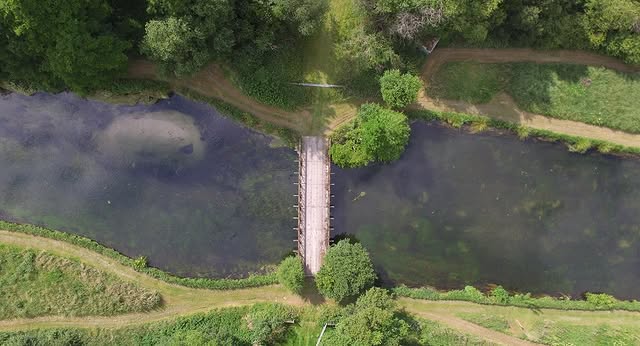Fly fishing for pike on the chalk streams | With River Keeper Nick
Nick has devoted much of his life to the Hampshire chalkstreams as a guide and river keeper. It was a pleasure to interview him and discuss how he targets pike on the fly, as well as learn from his observations managing rivers across the seasons. Few anglers have such insight into the broader ecosystem and fish behaviour than a man that spends the whole season, again and again, watching both fish and anglers trying to catch them…
All credit the photography and videos below is to Nick @hampshireriverkeeper. You can buy trout flies from Nick’s website here. Thank you to Nick for chatting with us.
“Chalkstreams are different.”
“When the winter rains come, the water goes down through the ground into big underground lakes. Then it gets pushed up though aquifers into the river through springs in the riverbed. If we get loads of rain here over a short period of time, the river will come up gradually over a few hours, whereas on a spate river, it comes up within minutes. By spring, it would take two days of heavy rain for it to do anything significant to the river. The trees and other vegetation drink most of the water before it ends up back in the river. Summer rainfall doesn’t equate to much.”

In January, the pike grow fat, and the river is resting
“It’s a different sort of beat in the winter. In the depths of winter in January, the river’s usually high. If we’ve had a lot of rain, it’ll be coloured. I tend to sort of do all the work in October, November time, and then have the rest of the winter off. In winter, there’s not much to do work wise, but January is coming into peak pike season.
The pike start to pack on the weight prior to spawning in March. These chalkstream pike are predominantly predating grayling and small trout… We keep the grayling season short so that the river banks have time to recover, without too much footfall while it’s muddy.

What’s your go-to pike fishing fly set-up?
A nine weight rod and a nine weight reel. I work with fishing tackle company called Vision, so I use a lot of their gear. They’re designed for that exact purpose – for catching pike. They’ve got a really fast action. When you’re casting these big flies, you don’t want a soft, floppy rod. It’s like casting a liquorice stick. You want something really responsive and these rods do exactly that.”
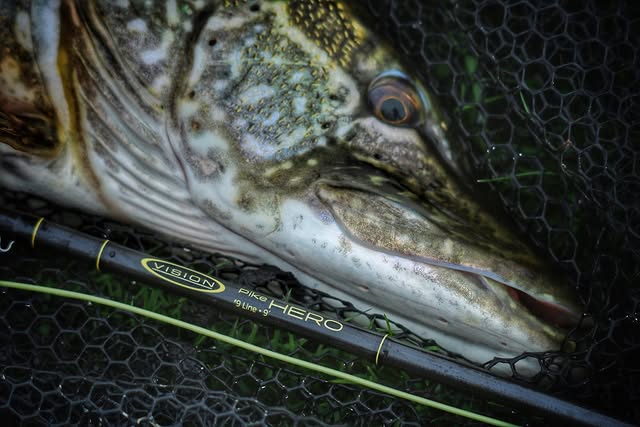
What is the best type of line in your view for pike on the fly?
“A slow sinking intermediate line”.
How long is your leader for pike on the fly?
“In terms of leader length I use 4-5ft of 40lb nylon, and then I’ll have about 12 inches of 40lb wire trace on the end.”
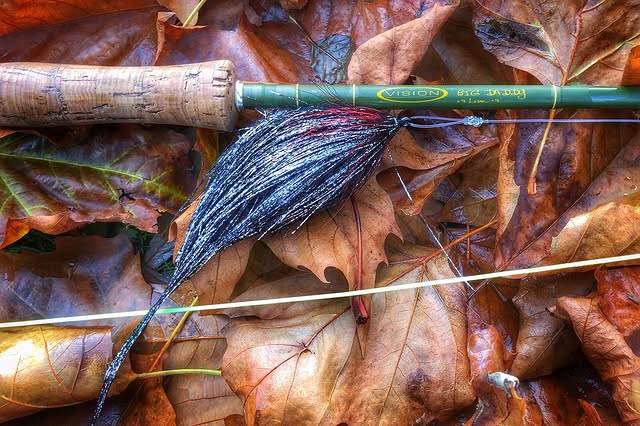
The best pike flies – flashy, 12″ long with 4/0+ hooks
“If they’re hungry, they’re going to have it whatever you put in front of them. They’re more sort of ambush opportunists than anything else. If they are hungry and they’re going to take something, whatever you put past them, they’ll take.”
“The flies that I use sort of represent grayling and trout colors, more than anything else, is silver, black. I’d only use one pattern of fly now. I use big singles. Just use a big single hook, size 4/0 even an 8/0, if the water is really dirty. The flies are sort of about 12 inches long. They’re quite heavily dressed, a lot of flash in them, big things.”
How to retrieve flies for pike
“You’re stripping in line the whole time. You’re making the fly work through the water, like trying to imitate an injured, dying fish, trying to make it look like an easy meal.”
“I keep the retrieve varied. You do slow, sort of jerky movements to make the fly active through the water. You want it to sort of dip up, down, and then slowly sink and give it another twitch, just keep it deep, working it near the bottom. And then vary the retrieve.”
“Some days they like a really quick retrieve. Other days, they want it sort of slow and almost barely moving, just a tiny bit of movement on it. With pike fishing and the fly, it’s all about the take. When they hit it, they just hit it so hard, and off they go. It’s really quite exciting.”

Pike Fishing Common Mistakes
Keep your rod pointed at the fly to keep a tight line
“The most common mistake that people make is to not point the rod at the fly. They’ll have the line almost at 90 degrees to the rod. You need to keep a tight line at all times because pike have got such a hard mouth, you’ve got to set the hook by pulling the line back instead of lifting the rod to strike. So if you’ve got any leeway in the rod or the line, they’ll grab the fly. It’ll get caught in the teeth of the mouse. They’ll shake their head, and they’ll be gone.”
Slow down your casting!
When using big flies, you’ve got to slow down your casting. Slow everything right down. You see people trying to rush it. You’re cast in a massive weight at the end of the day. It’s like trying to chuck a ferret around on the end of the line. It’s a big thing. Do half the speed of what you would do normally if you were trout fishing, and then you get the rod to work, as opposed to your arm.”
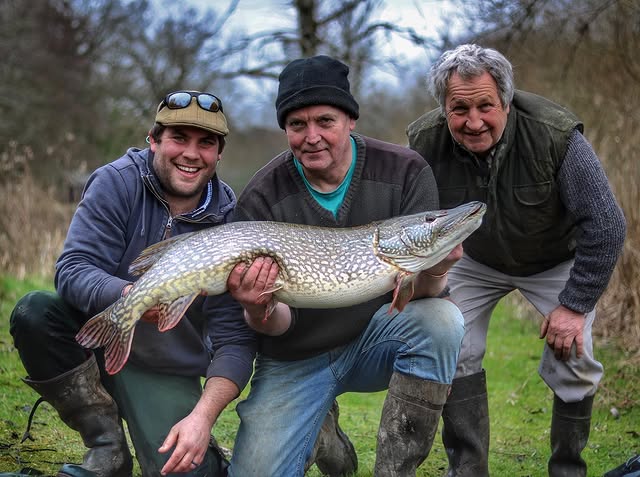
Handling Pike Safely
“The main thing that most novices sort of fall foul to is handling the fish once they’ve got it in the net and they want to try and pick it up. Obviously, Pike’s got a mouth full of teeth. They’ve got over 700 teeth, and they’ve got and all of their gill rate is aligned with teeth as well. So you’ve got to be very careful when handling the fish. And most people get some sort of injury. The fish thrashes its head around and they get cut.”
If you want to pick a pike up and sort of pose with it for a photo, you’ve got got to know how to handle it properly. There are certain places where you can put your hand under the gills of the fish, to hold it safely.”
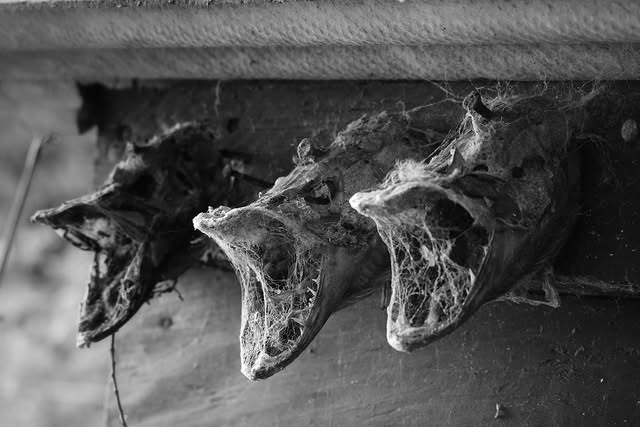
What happens when you kill all the big pike? Trout numbers decrease too…
My dad was a river keeper, and he actually won his job on the coin toss for the job. He’s been at it for 35 years. I’ve been a river keeper now for many years too…
“Years ago, everyone used to electrofish the river. You’d get in a boat, have two electric batons run off a generator, and two people with nets, and you just sort of float down the river. You’d have people pull you with a rope on each side, on the bank, and you’d electrify the water, stun all the fish and get all the pike out.”
They’d kill everything, back then… I mean, we’re talking 15–20 years ago. All the pike would be killed, all the grayling would even be taken out because they were seen as a pest, because they hoover up all the trout eggs and the salmon eggs when they spawn.”
“The first year I started here, we had a pike day — and this was back when you used to knock them all on the head — and I caught one fish of about 20lbs, bashed it on the head. And then 18 months later, I had an influx of loads of smaller pike. They went everywhere. I’ve regretted it ever since — killing that big one. You get all these smaller ones that just eat absolutely everything.”
“That was the last pike I knocked on the head. 18 months later, the whole bit of river that I looked after was just infested with little pike. And they’d all sit in the same places, because they like to sit in slack water, conserve their energy — because they’re predators, ambush predators. And a little pike is an easy meal for a big pike, because it’s just sat still. So the big pike will just hoover up these jack pike.”
Summer Heat and Fish Behavior
“The main factor impacting the fish is the water temperature, which is more significant than the river level height. As soon as the temperature starts getting up, it dissolves the oxygen in the water, and the fish struggle to breathe. So they become very lethargic, not hungry at all. They won’t feed.
“On a hot day, or if you’ve had a hot week, you’re waiting for the sun to get off the water and the water temperature just to drop down by a couple of degrees and then start feeding again.”
“A lot of the rivers are exposed to direct sunlight, where people have removed a lot of trees from the margin. This causes it to heat up, and the fish to become lethargic.”
Nick uses surgical pliers for swift unhooking of fish
“I use really long surgical pliers. Tthey’re about 12 inches long, just in case the fish is taking the fly right down the back of the throat. You can get in there and keep your hand away from the mouth so you don’t get cut.”
